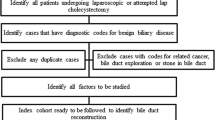Abstract
Background
Laparoscopic cholecystectomy (LC) is a common surgical procedure performed by surgical residents under the supervision of attending surgeons. There is a perception that performance of LC in a facility with a surgical training program provides a safer environment due to the presence of an assistant surgeon. The aim of this study was to compare the rate of bile duct injury, conversion, and mortality between hospitals with surgical residency programs (Group I) and hospitals without surgical training programs (Group II).
Methods
ICD-9 diagnosis and procedure codes were used to extract and analyze LC procedures from the Florida State Inpatient Database from 1997 through 2006. Bile duct injury was indicated by the code for a biliary reconstruction procedure performed during the same admission. Hospitals with surgical training programs were identified by participation in the Electronic Residency Application Service (ERAS) and verified by contact with each hospital.
Results
Between 1997 and 2006 there were 234,220 LCs identified, with 17,596 performed by Group I and 213,906 performed by Group II. Rate of BDI for Group I and Group II was 0.24 and 0.26%, respectively (p = 0.71). There was a significant difference noted in emergency and urgent admission rates (65.6% for Group I vs. 77.2% for Group II; p < 0.001) and conversion (9.1% for Group I vs. 7.5% for Group II; p < 0.001). Mortality was 0.44% for Group I and 0.55% for Group II (p = 0.060).
Conclusion
Our data suggest that bile duct injury rates are not influenced by the presence of a surgical residency program. In addition, there was no significant difference in mortality for LC at hospitals with surgical residencies when compared to hospitals without surgical residencies. A significant difference was noted in admission type and conversion rate but this did not appear to affect the rate of bile duct injury.
Similar content being viewed by others
References
Dolan JP, Diggs BS, Sheppard BC, Hunter JG (2005) Ten-year trend in the national volume of bile duct injuries requiring operative repair. Surg Endosc 19:967–973
Moore DE, Feurer ID, Holzman MD, Wudel LJ, Strickland C, Gorden DL, Chari R, Wright JK, Pinson CW (2004) Long-term detrimental effect of bile duct injury on health-related quality of life. Arch Surg 139:476–481
Boerma D, Rauws EA, Keulemans YC, Bergman JJ, Obertop H, Huibregtse K, Gouma DJ (2001) Impaired quality of life 5 years after bile duct injury during laparoscopic cholecystectomy: a prospective analysis. Ann Surg 234:750–757
Archer SB, Brown DW, Smith CD, Branum GD, Hunter JG (2001) Bile duct injury during laparoscopic cholecystectomy: results of a national survey. Ann Surg 234:549–558
Lee AY, Carter JJ, Hochberg MS, Stone AM, Cohen SL, Pachter HL (2008) The timing of surgery for cholecystitis: a review of 202 consecutive patients at a large municipal hospital. Am J Surg 195:467–470
Massarweh NN, Devlin A, Symons RG, Broeckel Elrod JA, Flum DR (2009) Risk tolerance and bile duct injury: surgeon characteristics, risk-taking preference, and common bile duct injuries. J Am Coll Surg 209:17–24
Flum DR, Dellinger EP, Cheadle A, Chan L, Koepsell T (2003) Intraoperative cholangiography and risk of common bile duct injury during cholecystectomy. JAMA 289:1639–1644
de Reuver PR, Grossmann I, Busch OR, Obertop H, van Gulik TM, Gouma DJ (2007) Referral pattern and timing of repair are risk factors for complications after reconstructive surgery for bile duct injury. Ann Surg 245:763–770
Scott TR, Zucker KA, Bailey RW (1992) Laparoscopic cholecystectomy: a review of 12, 397 patients. Surg Laparosc Endosc 2:191–198
Birkmeyer JD, Siewers AE, Finlayson EV, Stukel TA, Lucas FL, Batista I, Welch HG, Wennberg DE (2002) Hospital volume and surgical mortality in the United States. N Engl J Med 346:1128–1137
Urbach DR, Bell CM, Austin PC (2003) Differences in operative mortality between high- and low-volume hospitals in Ontario for 5 major surgical procedures: estimating the number of lives potentially saved through regionalization. CMAJ 168:1409–1414
Giger UF, Michel JM, Opitz I, Th Inderbitzin D, Kocher T, Krahenbuhl L; Swiss Association of Laparoscopic and Thoracoscopic Surgery (SALTS) Study Group (2006) Risk factors for perioperative complications in patients undergoing laparoscopic cholecystectomy: analysis of 22,953 consecutive cases from the Swiss Association of Laparoscopic and Thoracoscopic Surgery database. J Am Coll Surg 203:723–728
Disclosures
Vincent L. Harrison, James P. Dolan, Thai H. Pham, Brian S. Diggs, Alexander J. Greenstein, Brett C. Sheppard, and John G. Hunter have no conflicts of interest or financial ties to disclose.
Author information
Authors and Affiliations
Corresponding author
Appendix A: Inclusion and exclusion diagnoses and procedures with associated ICD-9-CM codes
Appendix A: Inclusion and exclusion diagnoses and procedures with associated ICD-9-CM codes
Inclusion
Laparoscopic cholecystectomy
-
Open Cholecystectomy (51.22) and Conversion from Laparoscopic to Open Procedure (V64.4)
-
Laparoscopic cholecystectomy (51.23)
-
Laparoscopic partial cholecystectomy (51.24)
Biliary reconstruction
-
Choledochoenterostomy (51.36)
-
Anastomosis of the hepatic duct to the gastrointestinal tract (51.37)
-
Other bile duct anastomosis (51.39)
-
Simple suture of the common bile duct (51.71)
-
Choledochoplasty (51.72)
-
Repair of other bile ducts (51.79)
Exclusion
Diagnoses
-
Malignant neoplasm of gallbladder and extrahepatic bile ducts (156.0, 156.1, 156.2, 156.8, 156.9)
-
Malignant neoplasm of the pancreas (157.0, 157.1, 157.2, 157.3, 157.4, 157.8, and 157.9)
-
Calculus of bile duct without mention of cholecystitis without (574.50) and with (574.51) mention of obstruction
-
Obstruction of the bile duct except cystic duct without mention of calculus (576.2)
-
Other specified disorders of biliary tract (adhesion, atrophy, cyst, hypertrophy, stasis, or ulcer) (576.8)
-
Chronic pancreatitis (577.1)
-
Cyst and pseudocyst of the pancreas (577.2)
-
Other diseases of the pancreas (atrophy, calculus, cirrhosis, fibrosis, pancreatic infantilism or necrosis, or pancreaticolithiasis) (577.8)
-
Unspecified disease of the pancreas (577.9)
-
Complications of transplanted organ: liver (996.82)
Rights and permissions
About this article
Cite this article
Harrison, V.L., Dolan, J.P., Pham, T.H. et al. Bile duct injury after laparoscopic cholecystectomy in hospitals with and without surgical residency programs: is there a difference?. Surg Endosc 25, 1969–1974 (2011). https://doi.org/10.1007/s00464-010-1495-y
Received:
Accepted:
Published:
Issue Date:
DOI: https://doi.org/10.1007/s00464-010-1495-y




